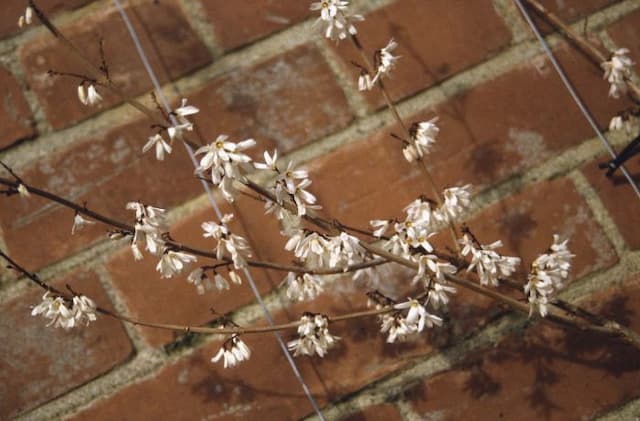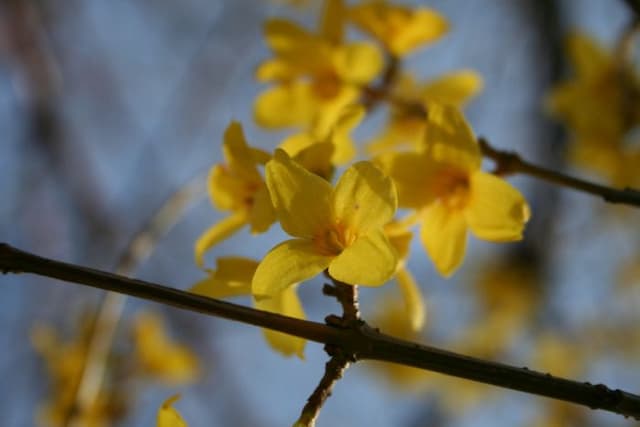Pumpkin Ash Fraxinus profunda

ABOUT
The plant commonly known as the pumpkin ash is characterized by its large, paddle-shaped leaves which are compound and consist of 5 to 9 leaflets arranged in a feathery fashion. These leaflets are typically dark green on top and paler underneath. In the fall, the leaves may turn into an attractive yellow, adding seasonal interest to the landscape. The bark of the pumpkin ash is gray and develops deep furrows and ridges as it matures, giving it a noticeably textured appearance. The flowers of the pumpkin ash are often inconspicuous, small, and may either be purple or without color. They bloom in clusters during the spring, often before the leaves fully emerge. After the flowering period, the plant produces fruits that are dry, winged, and single-seeded, commonly known as samaras. These winged fruits help in the dispersal of seeds by wind. The samaras are initially green but mature to a tan or brown color, and can be seen hanging in bunches from the branches, potentially providing food for wildlife during the autumn months. Overall, the pumpkin ash has a rounded canopy with stout, spreading branches that create dense shade beneath. Its appearance is quite robust and it contributes significantly to forested wetlands where it is often found, providing ecological value and aesthetic beauty.
About this plant
 Names
NamesSynonyms
Pumpkin Ash
Common names
Fraxinus tomentosa, Fraxinus pennsylvanica var. subintegerrima, Fraxinus pennsylvanica var. lanceolata.
 Toxicity
ToxicityTo humans
Fraxinus profunda, commonly known as the Pumpkin Ash, is not widely recognized for its toxicity to humans. There is a lack of substantial evidence or documented cases of poisoning from this plant species. While some parts of ash trees have been used traditionally for medicinal purposes, it is always advisable to exercise caution and avoid ingesting parts of plants that are not known to be edible, as they may cause adverse reactions in some individuals. It is recommended to consult with a healthcare professional or a botanist for more detailed information regarding the safety of using any plant for medicinal purposes.
To pets
Pumpkin Ash, the common name for Fraxinus profunda, does not have a well-documented profile regarding its toxicity to pets. Related species of ash trees are not commonly listed among plants that are poisonous to dogs, cats, or other domestic animals. However, as a general precaution, pet owners should prevent their pets from chewing on or ingesting parts of unknown plants, including the Pumpkin Ash, as they might cause gastrointestinal upset or other problems in sensitive individuals. If you suspect your pet has ingested an unknown plant and is displaying strange symptoms, it is advisable to contact a veterinarian immediately.
 Characteristics
CharacteristicsLife cycle
Perennials
Foliage type
Deciduous
Color of leaves
Green
Height
60-80 feet (18.3-24.4 meters)
Spread
45-50 feet (13.7-15.2 meters)
Plant type
Tree
Hardiness zones
3-9
Native area
North America
Benefits
 General Benefits
General Benefits- Shade Providing: Fraxinus profunda, also known as the pumpkin ash, can grow to be a large tree that offers significant shade, making it ideal for parks and large spaces.
- Habitat for Wildlife: The tree provides habitat and nesting sites for various bird species and other wildlife.
- Erosion Control: With its extensive root system, the pumpkin ash helps stabilize soil and prevent erosion, particularly along riverbanks and in wet areas.
- Aesthetic Appeal: The pumpkin ash is valued for its attractive form and foliage, which can add beauty to landscapes and gardens.
- Timber and Wood Products: The wood of Fraxinus profunda is used in the production of furniture, paneling, and other wood products due to its strength and workability.
- Canopy Layer Diversity: In forested areas, it contributes to the diversity of the canopy layer, supporting overall forest health and resilience.
- Drought Resistance: Once established, the pumpkin ash is relatively drought-tolerant, reducing the need for irrigation and maintenance.
- Carbon Sequestration: Like other trees, Fraxinus profunda plays a role in capturing atmospheric carbon dioxide, helping to mitigate climate change impacts.
 Medical Properties
Medical PropertiesThis plant is not used for medical purposes.
 Air-purifying Qualities
Air-purifying QualitiesThis plant is not specifically known for air purifying qualities.
 Other Uses
Other Uses- Woodworking: Pumpkin ash, as Fraxinus profunda is commonly known, is used in woodworking for making furniture and cabinetry, appreciated for its strength and grain pattern.
- Tool Handles: The wood of pumpkin ash is often used for tool handles due to its shock resistance and durability, ideal for hammers and axes.
- Baseball Bats: Similar to its cousin the white ash, pumpkin ash can be used to make baseball bats, taking advantage of its resilient and flexible wood.
- Veneer Production: The lumber is occasionally sliced into veneers for paneling and decorative wood products, showcasing its attractive grain.
- Canoe Construction: The lightweight and buoyant properties of pumpkin ash make it a good candidate for constructing traditional canoes.
- Food Smoking: Although not as popular as other woods, the chips of pumpkin ash can be used for smoking food to add a unique flavor.
- Woodturning: Craftsmen use pumpkin ash for woodturning to create ornamental objects, bowls, and spindles because it turns well on a lathe.
- Ornamental Trees: Some cultivars of pumpkin ash are planted as ornamental trees for their aesthetic qualities, such as foliage and form.
- Wildlife Habitat: Pumpkin ash trees provide a habitat and food source for various wildlife, particularly birds and small mammals.
- Agroforestry Practices: The species can be integrated into agroforestry systems due to its ability to grow in wetter soils, helping with land management and ecosystem diversity.
Interesting Facts
 Feng Shui
Feng ShuiThe Pumpkin Ash is not used in Feng Shui practice.
 Zodiac Sign Compitability
Zodiac Sign CompitabilityThe Pumpkin Ash is not used in astrology practice.
 Plant Symbolism
Plant Symbolism- Strength: The Fraxinus profunda, commonly known as the Pumpkin Ash, has wood that is known for its strength and elasticity, commonly used in tool handles and sporting goods, symbolizing the ability to withstand challenges and remain resilient.
- Endurance: The Pumpkin Ash can grow in wetland regions, displaying its capacity to endure and adapt to difficult environmental conditions, thus symbolizing the endurance through tough circumstances.
- Protection: In some cultures, ash trees, including the Pumpkin Ash, are considered protective due to their towering presence and longevity, serving as a symbol of safeguarding and sheltering what is beneath them.
- Transformation: Since ashes are linked to the mythological Phoenix bird, which is reborn from its ashes, the Pumpkin Ash could be associated with transformation, renewal, and the cyclical nature of life.
 Water
WaterPumpkin ash trees prefer consistently moist soil conditions but should not be waterlogged. During the growing season, water the tree once a week with about 15 to 20 gallons of water, especially if rainfall is less than an inch per week. In periods of drought, you may need to increase the frequency to twice a week. During the winter months, you can reduce watering since the tree will not be actively growing and will require less moisture. Always check the soil moisture level before watering to prevent overwatering. It’s important to water deeply and slowly, allowing the water to reach the root zone.
 Light
LightThe Pumpkin ash thrives best in full sun to partial shade. It should be planted in an area where it can receive at least six hours of direct sunlight daily. Partial shade is acceptable, especially in hotter climates which can protect the tree during the peak afternoon sun. The ideal spot for the Pumpkin ash would be an open space away from buildings or other trees that could block its access to sunlight.
 Temperature
TemperaturePumpkin ash trees are hardy in a range of temperatures, typically between -30°F to 100°F. They can survive brief periods outside of this range but may experience stress or damage if exposed to extremes for prolonged periods. The ideal temperature conditions for the Pumpkin ash reside within the temperate climate zones, avoiding prolonged exposure to temperatures above 100°F or below -30°F for optimal health and growth.
 Pruning
PruningPruning Pumpkin ash trees is essential to maintain their shape, remove dead or damaged branches, and improve air circulation. Pruning should be performed in late winter or early spring before new growth starts. It’s recommended to prune the tree every 2 to 3 years, targeting branches that cross or rub against each other, as well as any that are broken, diseased, or dead. Proper pruning cuts just outside the branch collar without leaving a stub will promote fast healing and reduce the risk of disease.
 Cleaning
CleaningAs needed
 Soil
SoilThe best soil mix for the pumpkin ash should be rich, well-draining, and loamy. It prefers a slightly acidic to neutral pH, ranging from 6.0 to 7.0. An organic compost amendment can enhance soil structure and fertility.
 Repotting
RepottingPumpkin ash trees are typically not repotted as they are large trees. Instead, they should be planted in a location where they can grow undisturbed.
 Humidity & Misting
Humidity & MistingPumpkin ash trees are tolerant of a variety of humidity conditions and do not require specific humidity levels as they are adaptable to their natural outdoor environment.
 Suitable locations
Suitable locationsIndoor
Growing pumpkin ash indoor isn't practical due to its large size.
Outdoor
Plant in moist, well-drained soil with full sun to partial shade.
Hardiness zone
4-9 USDA
 Life cycle
Life cycleThe Fraxinus profunda, commonly known as the pumpkin ash, starts its life cycle as a seed, which upon favorable conditions germinates and develops into a seedling. The seedling emerges from the soil and begins to grow leaves, establishing itself as a young sapling as it increases in height and thickness. As a sapling, pumpkin ash develops a more extensive root system and a stronger stem, eventually maturing into an adult tree with a broad, rounded crown. The adult pumpkin ash produces flowers in the spring; these are wind-pollinated and lead to the production of samaras, or winged fruits, which are dispersed by the wind to propagate the species. After reaching maturity, the tree can produce seeds annually for many years, contributing to the species' survival. Eventually, as with all living organisms, the pumpkin ash reaches the end of its life cycle, where it may succumb to environmental stress, diseases, or old age, decomposing and returning nutrients back to the soil.
 Propogation
PropogationPropogation time
Spring-Early Summer
Propogation: The most popular method of propagating the pumpkin ash, which is the common name for Fraxinus profunda, is through its seeds, typically sown in the fall after collection. The collected seeds usually require a period of cold stratification to break dormancy, which involves chilling the seeds in a moist substrate for 1-3 months at temperatures around 34-41°F (1-5°C) before planting. Once stratified, the seeds are sown in well-drained soil in a sunny location. Seedlings can then be grown on in pots before being transplanted to their final position in the landscape. This species is known for its water tolerance, so it is suitable for wetter areas where other ashes might not thrive.

![Forsythia [Marée d'Or]](/_next/image?url=https%3A%2F%2Fplants-admin.emdemapps.com%2Fimages%2Fplants%2F%2Fimages%2F604b5d7568293.png&w=640&q=75)







